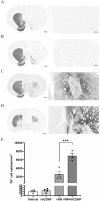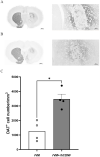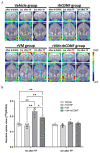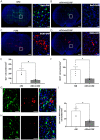Modulating Microglia/Macrophage Activation by CDNF Promotes Transplantation of Fetal Ventral Mesencephalic Graft Survival and Function in a Hemiparkinsonian Rat Model
- PMID: 35740467
- PMCID: PMC9221078
- DOI: 10.3390/biomedicines10061446
Modulating Microglia/Macrophage Activation by CDNF Promotes Transplantation of Fetal Ventral Mesencephalic Graft Survival and Function in a Hemiparkinsonian Rat Model
Abstract
Parkinson's disease (PD) is characterized by the loss of dopaminergic neurons in substantia nigra pars compacta, which leads to the motor control deficits. Recently, cell transplantation is a cutting-edge technique for the therapy of PD. Nevertheless, one key bottleneck to realizing such potential is allogenic immune reaction of tissue grafts by recipients. Cerebral dopamine neurotrophic factor (CDNF) was shown to possess immune-modulatory properties that benefit neurodegenerative diseases. We hypothesized that co-administration of CDNF with fetal ventral mesencephalic (VM) tissue can improve the success of VM replacement therapies by attenuating immune responses. Hemiparkinsonian rats were generated by injecting 6-hydroxydopamine (6-OHDA) into the right medial forebrain bundle of Sprague Dawley (SD) rats. The rats were then intrastriatally transplanted with VM tissue from rats, with/without CDNF administration. Recovery of dopaminergic function and survival of the grafts were evaluated using the apomorphine-induced rotation test and small-animal positron emission tomography (PET) coupled with [18F] DOPA or [18F] FE-PE2I, respectively. In addition, transplantation-related inflammatory response was determined by uptake of [18F] FEPPA in the grafted side of striatum. Immunohistochemistry (IHC) examination was used to determine the survival of the grated dopaminergic neurons in the striatum and to investigate immune-modulatory effects of CDNF. The modulation of inflammatory responses caused by CDNF might involve enhancing M2 subset polarization and increasing fractal dimensions of 6-OHDA-treated BV2 microglial cell line. Analysis of CDNF-induced changes to gene expressions of 6-OHDA-stimulated BV2 cells implies that these alternations of the biomarkers and microglial morphology are implicated in the upregulation of protein kinase B signaling as well as regulation of catalytic, transferase, and protein serine/threonine kinase activity. The effects of CDNF on 6-OHDA-induced alternation of the canonical pathway in BV2 microglial cells is highly associated with PI3K-mediated phagosome formation. Our results are the first to show that CDNF administration enhances the survival of the grafted dopaminergic neurons and improves functional recovery in PD animal model. Modulation of the polarization, morphological characteristics, and transcriptional profiles of 6-OHDA-stimualted microglia by CDNF may possess these properties in transplantation-based regenerative therapies.
Keywords: Parkinson’s disease; cerebral dopamine neurotrophic factor (CDNF); microglia activation; positron emission tomography; transplantation; ventral mesencephalic tissue.
Conflict of interest statement
The authors declare there are no conflicts of interest.
Figures










Similar articles
-
The Effect of Sertoli Cells on Xenotransplantation and Allotransplantation of Ventral Mesencephalic Tissue in a Rat Model of Parkinson's Disease.Cells. 2019 Nov 11;8(11):1420. doi: 10.3390/cells8111420. Cells. 2019. PMID: 31718058 Free PMC article.
-
AAV2-mediated striatum delivery of human CDNF prevents the deterioration of midbrain dopamine neurons in a 6-hydroxydopamine induced parkinsonian rat model.Exp Neurol. 2013 Oct;248:148-56. doi: 10.1016/j.expneurol.2013.06.002. Epub 2013 Jun 10. Exp Neurol. 2013. PMID: 23764500
-
Chronic infusion of CDNF prevents 6-OHDA-induced deficits in a rat model of Parkinson's disease.Exp Neurol. 2011 Mar;228(1):99-108. doi: 10.1016/j.expneurol.2010.12.013. Epub 2010 Dec 24. Exp Neurol. 2011. PMID: 21185834
-
Cerebral dopamine neurotrophic factor protects and repairs dopamine neurons by novel mechanism.Mol Psychiatry. 2022 Mar;27(3):1310-1321. doi: 10.1038/s41380-021-01394-6. Epub 2021 Dec 14. Mol Psychiatry. 2022. PMID: 34907395 Free PMC article. Review.
-
The time course of loss of dopaminergic neurons and the gliotic reaction surrounding grafts of embryonic mesencephalon to the striatum.Exp Neurol. 1996 Sep;141(1):79-93. doi: 10.1006/exnr.1996.0141. Exp Neurol. 1996. PMID: 8797670 Review.
Cited by
-
CDNF and MANF in the brain dopamine system and their potential as treatment for Parkinson's disease.Front Psychiatry. 2023 Jul 24;14:1188697. doi: 10.3389/fpsyt.2023.1188697. eCollection 2023. Front Psychiatry. 2023. PMID: 37555005 Free PMC article. Review.
-
Augmenting hematoma-scavenging capacity of innate immune cells by CDNF reduces brain injury and promotes functional recovery after intracerebral hemorrhage.Cell Death Dis. 2023 Feb 15;14(2):128. doi: 10.1038/s41419-022-05520-2. Cell Death Dis. 2023. PMID: 36792604 Free PMC article.
-
The inflammatory injury in the striatal microglia-dopaminergic-neuron crosstalk involved in Tourette syndrome development.Front Immunol. 2023 Apr 28;14:1178113. doi: 10.3389/fimmu.2023.1178113. eCollection 2023. Front Immunol. 2023. PMID: 37187752 Free PMC article.
-
Emerging Roles of Microglia in Blood-Brain Barrier Integrity in Aging and Neurodegeneration.Curr Neuropharmacol. 2024;22(7):1189-1204. doi: 10.2174/1570159X21666230203103910. Curr Neuropharmacol. 2024. PMID: 36740799 Free PMC article. Review.
-
Virus-induced brain pathology and the neuroinflammation-inflammation continuum: the neurochemists view.J Neural Transm (Vienna). 2024 Dec;131(12):1429-1453. doi: 10.1007/s00702-023-02723-5. Epub 2024 Jan 23. J Neural Transm (Vienna). 2024. PMID: 38261034 Free PMC article. Review.
References
-
- Bastide M.F., Meissner W.G., Picconi B., Fasano S., Fernagut P.-O., Feyder M., Francardo V., Alcacer C., Ding Y., Brambilla R. Pathophysiology of L-dopa-induced motor and non-motor complications in Parkinson’s disease. Prog. Neurobiol. 2015;132:96–168. doi: 10.1016/j.pneurobio.2015.07.002. - DOI - PubMed
-
- de la Fuente-Fernández R., Sossi V., Huang Z., Furtado S., Lu J.-Q., Calne D.B., Ruth T.J., Stoessl A.J. Levodopa-induced changes in synaptic dopamine levels increase with progression of Parkinson’s disease: Implications for dyskinesias. Brain. 2004;127:2747–2754. doi: 10.1093/brain/awh290. - DOI - PubMed
LinkOut - more resources
Full Text Sources
Miscellaneous

